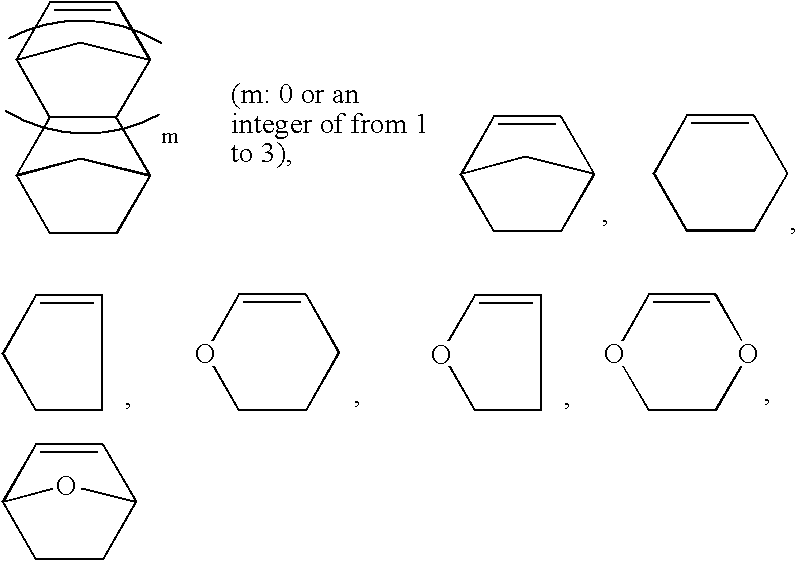Fine pattern forming method
a fine resist pattern and pattern technology, applied in the field of fine resist pattern formation, can solve problems such as difficulty in enhancing resolution, and achieve the effects of preventing reflection, preventing reflection, and preventing exposure light reflection
- Summary
- Abstract
- Description
- Claims
- Application Information
AI Technical Summary
Benefits of technology
Problems solved by technology
Method used
Image
Examples
preparation example 2
[0234] (Synthesis of Copolymer of Norbornene, Tetrafluoroethylene and tert-butyl-.alpha.fluoroacrylate)
[0235] A 100 ml autoclave equipped with a valve, pressure gauge and thermometer was charged with 8.5 g of 2-norbornene, 1.9 g of tert-butyl-.alpha.fluoroacrylate, 40 ml of HCFC-141b and 0.5 g of bis(4-tert-butylcyclohexyl)peroxydicarbonate (TCP), and while cooling with dry ice / methanol solution, the inside of a system was sufficiently replaced with nitrogen gas. Then 15.0 g of tetrafluoroethylene (TFE) was introduced through the valve, followed by shaking for reaction at 40.degree. C. for 12 hours. With the advance of the reaction, a gauge pressure was decreased from 12.0 kgf / cm.sup.2G before the reaction to 10.5 kgf / cm.sup.2G.
[0236] After releasing an un-reacted monomer, the polymerization solution was removed, followed by concentration and re-precipitation with methanol to separate a copolymer. Until a constant weight was reached, vacuum drying was continued and 8.7 g of the copo...
preparation example 3
[0239] (Synthesis of Copolymer of Norbornene, Tetrafluoroethylene and tert-butyl-.alpha.fluoroacrylate)
[0240] A 100 ml autoclave equipped with a valve, pressure gauge and thermometer was charged with 12.0 g of 2-norbornene, 4.9 g of tert-butyl-.alpha.fluoroacrylate, 40 ml of HCFC-141b and 0.5 g of bis(4-tert-butylcyclohexyl)peroxydicarbonate (TCP), and while cooling with dry ice / methanol solution, the inside of a system was sufficiently replaced with nitrogen gas. Then 15.0 g of tetrafluoroethylene (TFE) was introduced through the valve, followed by shaking for reaction at 40.degree. C. for 12 hours. With the advance of the reaction, a gauge pressure was decreased from 12.0 kgf / cm.sup.2G before the reaction to 10.5 kgf / cm.sup.2G.
[0241] After releasing an un-reacted monomer, the polymerization solution was removed, followed by concentration and re-precipitation with methanol to separate a copolymer. Until a constant weight was reached, vacuum drying was continued and 5.5 g of the cop...
preparation example 4
[0244] (Synthesis of Copolymer of Norbornene, Tetrafluoroethylene and tert-butyl-.alpha.fluoroacrylate)
[0245] A 500 ml autoclave equipped with a valve, pressure gauge and thermometer was charged with 19.5 g of 2-norbornene, 17.0 g of tert-butyl-.alpha.fluoroacrylate, 240 ml of HCFC-141b and 1.3 g of bis(4-tert-butylcyclohexyl)peroxydicarbonate (TCP), and while cooling with dry ice / methanol solution, the inside of a system was sufficiently replaced with nitrogen gas. Then 56.0 g of tetrafluoroethylene (TFE) was introduced through the valve, followed by shaking for reaction at 40.degree. C. for 12 hours. With the advance of the reaction, a gauge pressure was decreased from 11.0 kgf / cm.sup.2G before the reaction to 10.2 kgf / cm.sup.2G.
[0246] After releasing an un-reacted monomer, the polymerization solution was removed, followed by concentration and re-precipitation with methanol to separate a copolymer. Until a constant weight was reached, vacuum drying was continued and 28.5 g of the ...
PUM
| Property | Measurement | Unit |
|---|---|---|
| wavelength | aaaaa | aaaaa |
| transparency | aaaaa | aaaaa |
| melting point | aaaaa | aaaaa |
Abstract
Description
Claims
Application Information
 Login to View More
Login to View More - R&D
- Intellectual Property
- Life Sciences
- Materials
- Tech Scout
- Unparalleled Data Quality
- Higher Quality Content
- 60% Fewer Hallucinations
Browse by: Latest US Patents, China's latest patents, Technical Efficacy Thesaurus, Application Domain, Technology Topic, Popular Technical Reports.
© 2025 PatSnap. All rights reserved.Legal|Privacy policy|Modern Slavery Act Transparency Statement|Sitemap|About US| Contact US: help@patsnap.com



